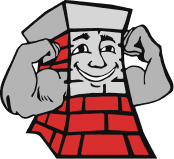Chimney Fires Can Be Prevented
Don’t Let the Good Fires Bring on a Bad One –
by Dave Lamb – dave@mychimneys.com
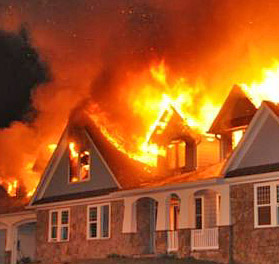 According to the latest statistics available, there are over 25,000 Chimney Fires per year in the US that are responsible for over 125 million dollars in property damage. The most sobering statistics relate to deaths and injuries that can result from chimney fires that spread into house fires. Built up creosote is responsible for many of those fires, along with deficiencies in chimney linings and structures that allow high temperatures, embers and sparks to reach combustible areas that are adjacent to your chimney or fireplace.
According to the latest statistics available, there are over 25,000 Chimney Fires per year in the US that are responsible for over 125 million dollars in property damage. The most sobering statistics relate to deaths and injuries that can result from chimney fires that spread into house fires. Built up creosote is responsible for many of those fires, along with deficiencies in chimney linings and structures that allow high temperatures, embers and sparks to reach combustible areas that are adjacent to your chimney or fireplace.
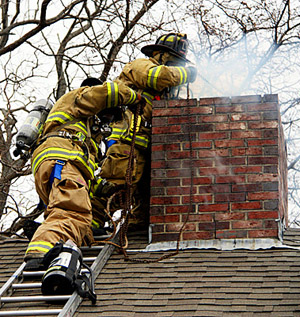 No one wants to ever experience a chimney fire, or worse yet a fire in the chimney that spreads to the home as many times happens. This is an important issue and there are things that you can do to protect yourself from the chances of a chimney fire ever affecting your home or your family.
No one wants to ever experience a chimney fire, or worse yet a fire in the chimney that spreads to the home as many times happens. This is an important issue and there are things that you can do to protect yourself from the chances of a chimney fire ever affecting your home or your family.
Even a small chimney fire that doesn’t spread is never a good sign and it is very important to know how to recognize one as it is occurring and to prevent them from happening in the first place. Many times homeowners learn that they had a chimney fire after the fact, during a chimney inspection.
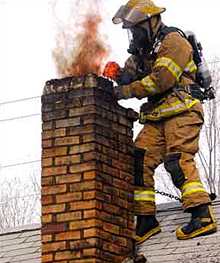 Know how to identify the warning signs of a chimney fire raging inside of your chimney. There is a wide range of what to expect if a chimney fire occurs. These fires can be very dramatic, as flames may lap out of the top of your chimney, and a roaring sound could be heard even by your neighbors. Dark smoke will often billow out of the chimney top and those inside the home may be frightened to hear what sounds like a train or air plane flying close by. These fires are often described as producing a load sucking noise, or rattling pipes. Although many chimney fires cause a disturbance, you may also have a chimney fire and never know it. Besides the raging blazes, slow burning fires can also take place within the chimney walls and you may never know these fires are going on. These fires may burn silently, but their silence is no indication of the harm they may cause, slow burning fires burn at incredibly high temperatures and can cause serious structural damage to the chimney as well as nearby walls of the home. Regardless of how dramatic the blaze sounds, all chimney fires can cause substantial damage and mandate damage control once they are put out.
Know how to identify the warning signs of a chimney fire raging inside of your chimney. There is a wide range of what to expect if a chimney fire occurs. These fires can be very dramatic, as flames may lap out of the top of your chimney, and a roaring sound could be heard even by your neighbors. Dark smoke will often billow out of the chimney top and those inside the home may be frightened to hear what sounds like a train or air plane flying close by. These fires are often described as producing a load sucking noise, or rattling pipes. Although many chimney fires cause a disturbance, you may also have a chimney fire and never know it. Besides the raging blazes, slow burning fires can also take place within the chimney walls and you may never know these fires are going on. These fires may burn silently, but their silence is no indication of the harm they may cause, slow burning fires burn at incredibly high temperatures and can cause serious structural damage to the chimney as well as nearby walls of the home. Regardless of how dramatic the blaze sounds, all chimney fires can cause substantial damage and mandate damage control once they are put out.
If you think there is a chimney fire in your chimney, what do you do?
1. First, evacuate the home and make sure that everyone is out of harm’s way.
2. Call the fire department to let them know about the situation.
If the situation is deemed safe and everyone is out of harm’s ways, other actions may be taken.
3. Take all measures to cut off the fire’s air supply. This includes closing the glass doors in front of the fire and shutting the fire damper as well.
4. Spray down the roof with a garden hose to prevent the fire from spreading to other areas of the home.
5. Wait for the fire department to respond and direct them where to go when they arrive.
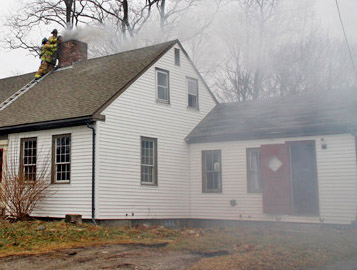 After a chimney fire it is important to get a professional’s opinion of what the cause of the fire was and ways to prevent it from happening again. It the fire happened once, it can happen again and the situation needs further addressing after the flames are put out. Never relight a fire after a chimney fire has taken place without having your chimney inspected first.
After a chimney fire it is important to get a professional’s opinion of what the cause of the fire was and ways to prevent it from happening again. It the fire happened once, it can happen again and the situation needs further addressing after the flames are put out. Never relight a fire after a chimney fire has taken place without having your chimney inspected first.
What causes chimney fires?
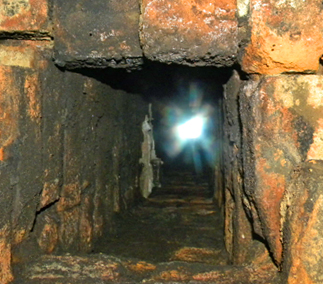
The black residue is creosote, which can ignite easily and start a chimney fire. Worse yet, this chimney has no liner at all - a very risky and unsafe condition.
The build-up of creosote along the chimney lining walls can facilitate the start of a chimney fire. This build-up is caused by the unburned materials in the smoke accumulating along the chimney walls and creating a sticky substance that can easily catch fire. The smoke from the fire contains a substance similar to tar and when the temperatures within the chimney are below 250 degrees Fahrenheit, the substance will condense along the chimney surface. When the temperature drops below 150 degrees Fahrenheit, the substance turns into a dark, sticky substance that is also highly flammable.
What causes the creosote?
All fires create soot and residue build-up, especially wood burning fireplaces and stoves. There are many factors that can lead to the build-up of creosote. The burning of unseasoned wood leads to the fire burning at a lower temperature and thus not as thoroughly or completely as a fire with higher temperatures. Along these same lines, the location of your chimney may also contribute to the amount of creosote buildup your chimney has. For example, a chimney on the exterior of a home will produce more buildup than a chimney in the center of the home because an exterior chimney flue will have cooler temperature than one surrounded by the warm rooms of a home. Most creosote is removed during annual chimney cleaning performed by chimney sweeps.
What type of damage is caused by a chimney fire?
Different types of chimneys may result in different types of damage occurring after a chimney fire.
 For masonry chimneys, the damage from an unwanted fire may come in the form of cracked chimney walls or broken pieces of tile from the liner and may also cause chimney liners to collapse from the high heat. Many times, in the first chimney fire, the tiles of the liner will crack and mortar will be displaced which then leaves a pathway for the next chimney fire to get to the roof and into other flammable materials of the home. Also, even if the chimney itself is not damaged, if the heat within the chimney walls is high enough, it may light part of the home though the masonry walls.
For masonry chimneys, the damage from an unwanted fire may come in the form of cracked chimney walls or broken pieces of tile from the liner and may also cause chimney liners to collapse from the high heat. Many times, in the first chimney fire, the tiles of the liner will crack and mortar will be displaced which then leaves a pathway for the next chimney fire to get to the roof and into other flammable materials of the home. Also, even if the chimney itself is not damaged, if the heat within the chimney walls is high enough, it may light part of the home though the masonry walls.
For prefabricated chimneys, the destruction comes in a slightly different form. Despite the fact that these metal, factory built chimneys must pass regulated guidelines, damage from a chimney fire can still occur. For this type of chimney, collapsed or distorted seams of the lining are common results of a chimney fire. In this case, the entire lining must be replaced before the fireplace is once again used.
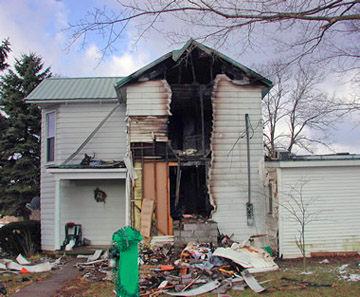 Chimney fires are a dangerous and serious problem to have, but the good news is that they are also almost entirely preventable. You must be careful to only burn materials that are ready and meant to be burned. For example, only use seasoned, dry wood, newspapers and dry kindling. Burning cardboard boxes, regular trash or wrapping paper will cause the creation of excess creosote and put your home and family in danger. While using the correct fuel is important, a chimney fire can still occur even after taking these precautions. This is why annual chimney inspections and cleanings are a critical part of home maintenance.
Chimney fires are a dangerous and serious problem to have, but the good news is that they are also almost entirely preventable. You must be careful to only burn materials that are ready and meant to be burned. For example, only use seasoned, dry wood, newspapers and dry kindling. Burning cardboard boxes, regular trash or wrapping paper will cause the creation of excess creosote and put your home and family in danger. While using the correct fuel is important, a chimney fire can still occur even after taking these precautions. This is why annual chimney inspections and cleanings are a critical part of home maintenance.
If your chimney is clean, there will not be a fire; therefore, regular inspections and cleanings are necessary to ensure you and your home have a safe and happy winter season.


